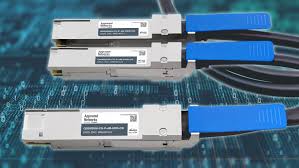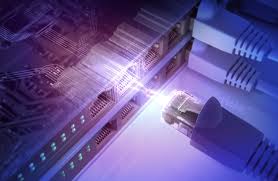
“AI Revolutionizes the Ethernet vs. InfiniBand Debate: A New Era of Networking 2025”

In the ever-evolving world of high-performance networking, the battle between Ethernet and InfiniBand has long been a focal point of debate. These two technologies have dominated the landscape of data transfer for decades, each with its distinct advantages and drawbacks. However, a new player has entered the field—artificial intelligence (AI). As AI continues to make its mark across industries, it is now reshaping the Ethernet vs. InfiniBand debate, offering fresh perspectives, performance improvements, and transformative changes in the way we understand and implement network architectures.
In this blog, we will explore how AI is revolutionizing the Ethernet and InfiniBand debate, examining how AI is influencing the performance, efficiency, and application of both technologies and what this means for the future of networking.
Wikipedia
The Ethernet vs. InfiniBand Landscape: A Brief Overview

Before diving into the impact of AI, let’s quickly review the two main technologies at the heart of this debate.
Ethernet is the most widely used networking standard for connecting devices across local area networks (LANs) and wide area networks (WANs). It is popular for its scalability, cost-effectiveness, and compatibility with various devices. Ethernet has evolved over the years, with newer versions supporting higher speeds and more advanced features, such as low-latency communication.
InfiniBand, on the other hand, is a high-performance, low-latency interconnect standard primarily used in high-performance computing (HPC) environments, data centers, and supercomputing clusters. InfiniBand excels in environments that require large-scale data transfer with minimal delay and high throughput, such as scientific research, financial modeling, and AI training.
Despite their differences, Ethernet and InfiniBand have both carved out significant niches in the networking ecosystem. However, as technology advances, AI is emerging as a key driver of innovation in both arenas.
AI and the Evolution of Ethernet
Historically, Ethernet was designed with a focus on simplicity, reliability, and scalability. As network demands grew, so did Ethernet’s ability to handle larger volumes of data and support higher speeds. However, even with advancements such as 100 GbE (Gigabit Ethernet) and beyond, Ethernet’s design still struggled with certain limitations, especially in environments requiring low latency and high-throughput networking.
Enter AI. Artificial intelligence and machine learning algorithms are now being used to enhance Ethernet’s capabilities in ways previously unimagined. One of the most significant impacts of AI on Ethernet is in the area of network optimization. AI-powered solutions can now analyze vast amounts of network traffic data in real time, enabling systems to predict and adjust bandwidth allocation, congestion management, and fault detection.
For instance, AI can be employed to dynamically adjust Ethernet traffic flow, ensuring that data is routed in the most efficient manner possible. It can also help reduce network congestion by predicting potential bottlenecks and proactively redistributing traffic before it becomes an issue. These improvements are particularly valuable in large-scale enterprise environments, where network traffic is often unpredictable and constantly shifting.
Moreover, AI can automate routine network management tasks, reducing the workload on IT professionals and enabling more agile, responsive networks. For example, AI-driven systems can automatically detect and resolve network anomalies, ensuring that performance stays optimal without the need for constant human intervention.
AI and the Future of InfiniBand

InfiniBand has long been the go-to solution for environments where performance and speed are paramount. Its ability to handle low-latency, high-throughput communication has made it a staple in supercomputing clusters and research facilities. However, as the demands of modern workloads increase, even InfiniBand needs to evolve to keep up.
AI is poised to play a significant role in pushing the limits of InfiniBand’s performance. One of the most exciting developments is the integration of AI in InfiniBand network design and management. With machine learning algorithms, InfiniBand can now intelligently optimize data paths, minimize latency, and predict and address performance bottlenecks in real time. AI can also help InfiniBand systems self-adjust in response to workload changes, improving the system’s overall responsiveness and efficiency.
Another important development is the use of AI in predictive analytics for InfiniBand networks. By leveraging machine learning models, administrators can anticipate network issues before they arise, whether it’s hardware failures, traffic overloads, or other performance concerns. This proactive approach can lead to greater system uptime and a reduction in costly downtime, which is critical in environments where every millisecond counts.
Additionally, AI is enhancing InfiniBand’s ability to support modern workloads like deep learning, which requires massive amounts of data transfer between GPUs and other processors. AI algorithms are helping to accelerate these workloads by ensuring that the InfiniBand fabric is optimized for high-bandwidth, low-latency communication, thereby reducing the time needed for training complex AI models.
The AI-Driven Hybrid Future

The future of networking is likely to be a hybrid model that combines the best features of both Ethernet and InfiniBand, enhanced by AI capabilities. While Ethernet may dominate in broader, cost-sensitive applications, InfiniBand will continue to be the preferred choice for high-performance, latency-sensitive tasks. However, the boundaries between these two technologies are becoming more fluid as AI helps bridge the gap.
AI-driven network fabrics are already emerging that integrate both Ethernet and InfiniBand technologies in a seamless way. These hybrid solutions leverage AI to dynamically adjust the network to meet the specific needs of each workload, providing the best of both worlds. For example, a data center might use InfiniBand for high-throughput applications like scientific simulations while relying on Ethernet for less demanding tasks, all while AI ensures that resources are allocated efficiently.
In addition to hybrid networking, AI is also influencing the development of new protocols and standards that could further blur the lines between Ethernet and InfiniBand. As AI continues to advance, it may unlock entirely new networking paradigms that combine the scalability and cost-effectiveness of Ethernet with the performance and speed of InfiniBand, all while being driven by AI’s predictive and optimization capabilities.
The Impact of AI on Networking: A Paradigm Shift

The integration of AI into the Ethernet vs. InfiniBand debate marks the beginning of a new era in networking. AI is not just a tool for improving performance; it is fundamentally transforming how networks are designed, managed, and optimized. With AI, both Ethernet and InfiniBand are evolving in previously unimaginable ways, unlocking new levels of efficiency, speed, and flexibility.
For businesses, this means that they can now achieve the high-performance networking they need without sacrificing cost-effectiveness or scalability. For researchers and scientists, AI-powered InfiniBand networks will continue to push the limits of what is possible in fields like AI research, quantum computing, and big data analysis.
As AI continues to evolve, it’s clear that the networking industry will never be the same. The age-old debate between Ethernet and InfiniBand may no longer be about choosing one over the other but about leveraging the strengths of both, enhanced by the power of AI. The future of networking is smarter, faster, and more adaptable than ever before, and AI is leading the way.
DPV NATION
Conclusion
AI is reshaping the landscape of high-performance networking by revolutionizing the debate between Ethernet and InfiniBand. Through intelligent optimization, predictive analytics, and real-time adjustments, AI is driving both technologies to new heights, enabling more efficient, cost-effective, and high-performing networks. Whether you’re in the enterprise space, a supercomputing facility, or working with cutting-edge AI models, the role of AI in networking is undeniable. As AI continues to evolve, so too will the networks that power our digital world, ensuring that they are faster, smarter, and more capable than ever before.







